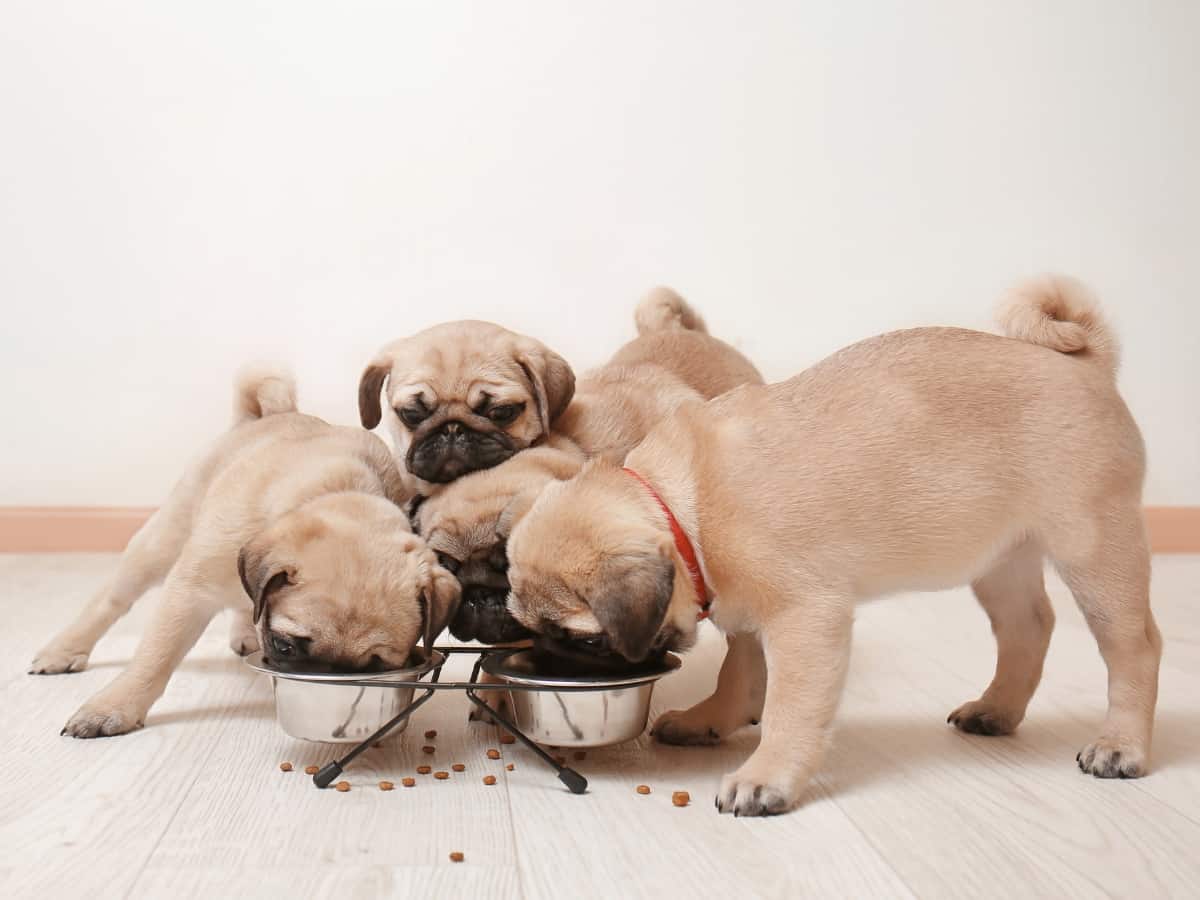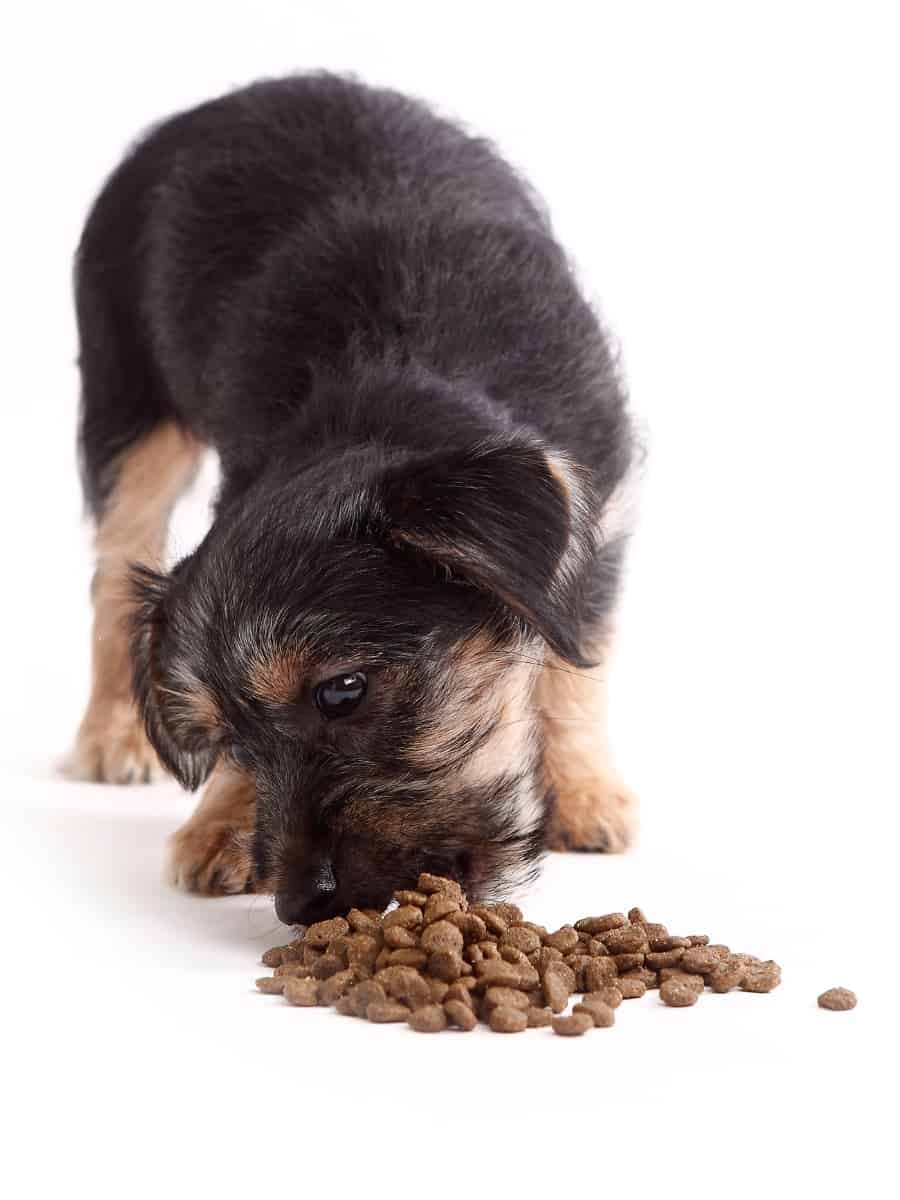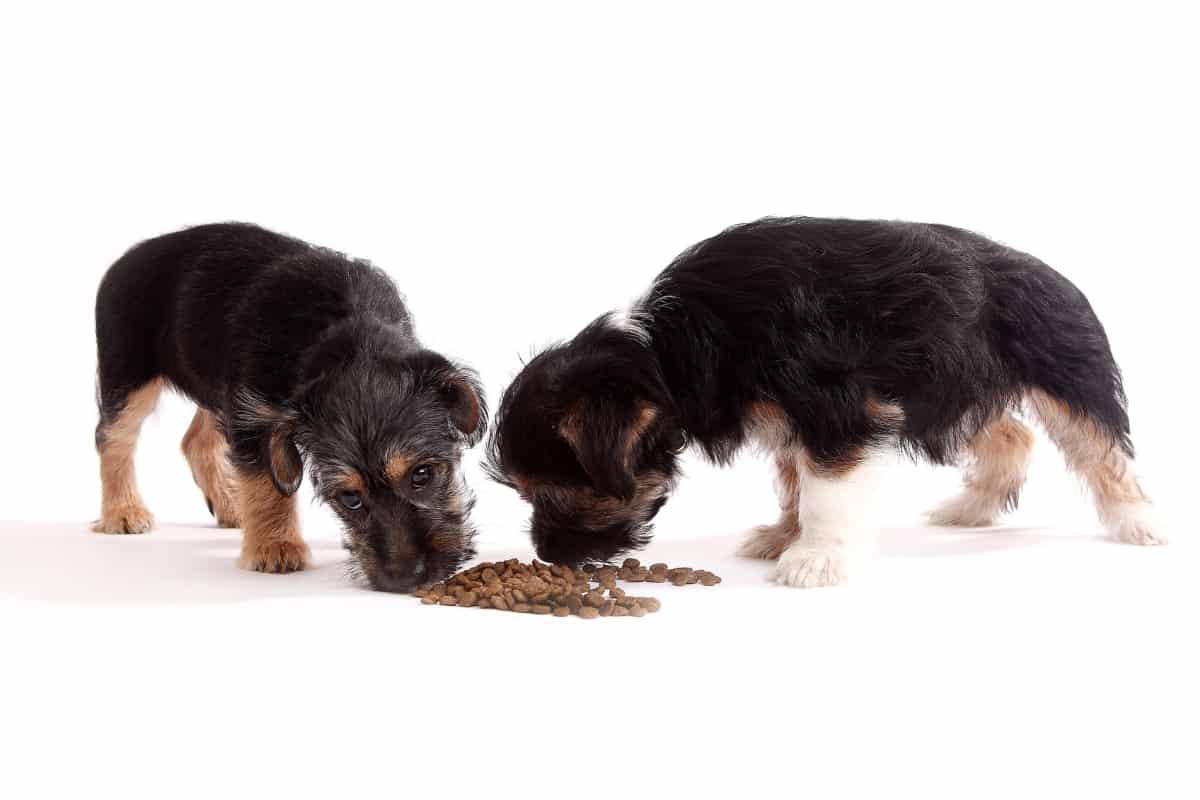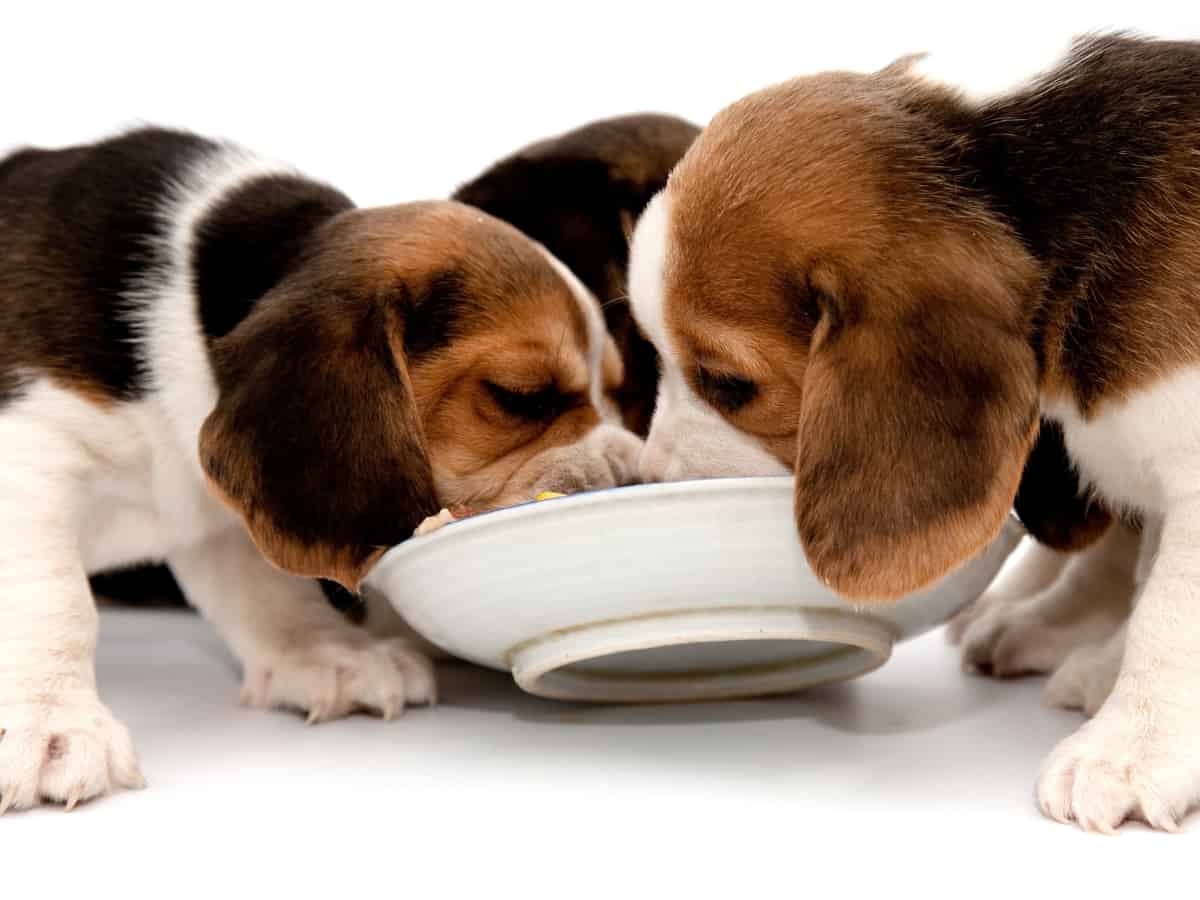According to the proponents of a free-feeding diet, leaving dog food out all day can be the perfect thing for your dog. But in reality, open-choice feeding works for very few dogs who don’t have the appetite to consume even a single serving in one sitting. For most dogs, leaving food out all day is not recommended.
The cons of free feeding your dog include the risk of food contamination, obesity, food aggression, and the degradation of the dog’s discipline and feeding schedule. The pros of free feeding are that it’s good for picky eaters, senior dogs, or dogs with health issues, and it’s convenient for the dog owner.
In this article, you will find out more about the specific reasons not to leave dog food out all day, including:
- Your dog can become obese
- Your dog’s discipline might be affected
- Dog food might get contaminated
- Your dog might challenge your authority
- Your dog might get territorial over his food
- The food might attract birds, raccoons, and other pests
- You might be unable to use food as a training incentive

Free Feeding vs. Scheduled Feeding
Free feeding or graze feeding is when an owner leaves food out for their dog to eat whenever they like. The dog has access to food at all times and can eat as much or as little as they want throughout the day.
Scheduled feeding is when a dog is fed on a regular schedule, with measured portions appropriate for their age, size, and activity level. For example, I feed my 90 lbs German Shepherd two meals daily. The amount of food I provide her is suited to her age (senior dog) and activity level.
Scheduled feeding is better than free feeding for the dog’s overall health, discipline, and hygiene, while free feeding is ideal for a dog that might not eat a lot in a short period.
Scheduled feeding should be the default option for any dog raised as a pet. Structure and schedule can help the dog be more manageable in the future. Moreover, the fact that you decide when he eats gives you the authority that you can use to make your dog behave better.
When a dog free feeds, he can eat more than he needs. That said, this drawback isn’t entirely absent in scheduled feeding. You can manage portions in scheduled as well as in open feeding methods.
Still, the drawbacks of contamination and pest attraction make free feeding a suboptimal choice at best and a downright dangerous one at worst. Still, plenty of dogs grow healthy and strong while being free-fed. This suggests that there are certain instances where free feeding can be good.
Pros and Cons of Free Feeding Your Dog
Here is an at-a-glance table comparing free feeding vs. scheduled feeding.
| Free Feeding Pros | Free Feeding Cons | Scheduled Feeding Pros | Scheduled Feeding Cons |
|---|---|---|---|
| Pets can eat as much as they need; they are never left feeling famished between meals. | The number one con with free feeding is that it puts a lot of pets at risk for over-eating and obesity. | You can control the portions easily. | You have to be home to feed your pet (although there are automatic feeders on the market you can get to address this). |
| Dogs never have to miss a meal if you’re running late; you don’t have to worry if you can’t get home right at feeding time. | It can be hard to do in multiple pet households (especially if they are on different food). | It gives your dog structure to his day and in the home hierarchy (he knows you are the giver of food). | It might encourage your pet to gulp or wolf down his food since he greatly anticipates it. |
| There are fewer food-guarding issues – because they always have access to food and don’t have to worry about when their next meal is coming; it takes the value away from the food. | Because the dog eats throughout the day, it can cause difficulty with potty training (you can’t anticipate their need for trips outside as quickly as you can with a scheduled meal time). | It helps with potty training, as you know when he will need to go outside after a meal. | It might lead to food guarding. If he only gets access to food for a little while twice a day, those times can possibly become very high-value and high-stress. |
| Good for active pets (or pets with varied levels of activity) because if your pet needs to eat more calories on a certain day to account for extra calories burned, he can. | Depending on the environment and your setup, food left out can sometimes promote an unhygienic situation. | It helps keeps things clean (both in the sense that you don’t have food sitting out and visually since you can put the bowls out of sight between meals). | |
| Some studies have shown some pets, like cats, eat best like this (but, of course, some contradict that). | It helps you more easily notice when your pet’s appetite suddenly shifts (thereby alerting you to a possible sickness early). |
Cons of Free Feeding Your Dog
You should not leave dog food out all day or even for most of the day because it can breed poor dieting discipline and lead to missed training opportunities for puppies. Sometimes, free-feeding an older dog can be a better solution, but most dogs should have a predictable schedule.
Free feeding your dog can be easy and convenient for you. It also ensures that your dog never starves. But these perks, despite seeming very valuable, are outweighed by the many disadvantages of leaving dog food out all day.
Here are the cons of free feeding your dog:

1. Your Dog Can Become Overweight
Humans understand the effect of food on their weight and still can’t manage to self-regulate their food consumption. What do you think makes your dog any better at self-control? Leaving food out all day can make your dog obese because he will start snacking out of boredom.
2. Your Dog Can Lose Their Discipline
Eating on a set schedule doesn’t just improve your dog’s hunger and satiation cycle, but it also develops discipline. The better your dog is at pattern recognition and predictable routine-following, the better he is.
You can de-domesticate your pet by taking predictable repetition out of one of the most important aspects of being a dog (having food). Delaying gratification and having patience are two of the most valued traits in a pet dog. Free feeding actively erodes both of these. When a puppy is free-fed, he is robbed of the opportunity to build discipline.
3. Your Dog Can Get Sick From Contaminated Food
You may wonder if leaving your dog’s food out all day is safe.
As if being poorly disciplined wasn’t bad enough for a dog, free-feeding puts your dog at a further disadvantage by increasing the risk of contamination. Food kept outside is exposed to the elements and organic entities ranging from fungi to large birds.
Watch This Video To Learn The Disadvantages of Free Feeding…
4. Your Dog Might Not Value Your Authority As Much
You might have heard that dogs should never be scolded for anything they did hours ago because they are too simple to connect cause and effect in such cases.
The same difficulty in connecting cause and effect comes into play when a dog is free-fed. When you feed your dog a set schedule, you decide the schedule. By seeing you pour food moments before he eats it, your dog can connect you to the role of the provider.
But if you fill his bowl before he wakes up and eats from it whenever he wants, he might start seeing himself as the hunter fetching his food independently. This can be troublesome and can even make your dog more territorial.
5. Your Dogs Might Fight Each Other Over Food
If you have more than one pet, the territorial nature of your dogs might lead to clashes. A balance of cooperation and competition is crucial in a household with multiple pets. Free feeding sets up the stakes such that the dog with the most might get to have food first.
This can make your dog feel abandoned if he doesn’t get to eat first. And the dog that eats first might get possessive and even more territorial around his bowl. The drawback applies to contexts where multiple dogs are in the picture, though.
6. The Food Might Attract Pests
Even when just one dog is in a house, there can be multiple mouths angling for food. Free feeding can attract pests, including but not limited to birds, rabbits, and raccoons.
In mild cases, this can make your backyard dirty. In more severe cases, pests can harm your dog. From direct attacks to contamination, there are many ways in which pests might damage a dog.
See also: 7 Easy Ways To Keep Birds From Eating Dog Food
7. Your Dog Might Miss Out On Training Opportunities
Food can be a significant motivator for positive reinforcement. If you free-feed your dog, you cannot position food as a joyous treat.
Even if you give your dog a treat or two after he executes a command, his satisfaction won’t be as intense. This can ripple out and affect how much the dog is motivated to listen to you in the future.
A $5 bill doesn’t motivate an adult as much as it encourages a kid because an adult has free choice access to a bunch of five-dollar bills. That doesn’t mean the adult will pass on a $5 bet. The case is similar to a free-fed dog in that he is motivated to follow instructions to an extent but isn’t as driven because he can access food whenever he wants.

8. House Training Is Harder
House training can be more challenging if you are free feeding your dog. When dogs have unrestricted access to food, they may need to eliminate more frequently and irregularly, making it difficult to establish a consistent potty schedule.
Scheduled feeding helps with potty training, as you have a good sense of when your dog will need to go outside, usually shortly after a meal.
Pros of Free Feeding Your Dog
Free feeding your dog is not as black and white as its proponents or even the earlier portions of this article might make it out to be. It is just that, in most cases, free feeding isn’t the solution that’s best for the dog. Let’s explore the specific situations where free feeding can be good.
- When the dog is a slow eater – If your dog eats less than half the recommended portion for his body weight and age, you shouldn’t empty his bowl and wait for the next meal to fill it back up. Let him free-feed until he finishes his food.
- When the dog gets old and uninterested in food – Sometimes, your senior dog might be uninterested in food because it hurts to wolf it down quickly. If you notice that the bowl is full despite being out all day, you have to start looking at the reasons behind your dog’s persistent disinterest in food.
- When the dog’s nutritionist recommends it – If you have taken your dog to a vet or a nutritionist and one has recommended free feeding, then you should let your dog free feed. Make sure to follow the vet’s instructions regarding the food’s content as well, though.
- When the owner has ADHD – If you’re neurodivergent and fear you will forget to feed your dog, you can rely on an automatic feeder or let your dog free-feed. When you choose to let the dog free feed, remember to portion the total food to match the dog’s daily nutrition requirements.
Switching From Free Feeding to Scheduled
To transition from free feeding to scheduled feeding for your pet, start by checking the appropriate daily amount on the food package. Divide this amount by two and offer one portion in the morning and one in the evening.
During mealtime, leave the food bowl down for 15-20 minutes. If your dog doesn’t eat or finishes the food before the time is up, take the bowl up.
It’s normal for your furry friend to take a few meals to adjust to the new schedule, so don’t panic if they don’t eat. Avoid doubling the portion or adding treats at the next meal. This teaches your dog to hold out for special treats, which can lead to overfeeding.
Resist the urge to coddle your pet or give them extra attention during mealtime. Keep offering meals twice a day, and your pet will eventually eat when they’re hungry enough.
Remember, your pet won’t starve, and it’s essential to establish a consistent feeding routine. If you have concerns about your pet’s health or eating habits, consult your veterinarian.

Switching From Scheduled to Free Feeding
Switching your dog from scheduled to free feeding can be challenging, as it requires changing your dog’s established routine. However, if you’ve decided that free feeding is the best option for your dog, here are some steps to follow:
- Gradually introduce free feeding: Rather than making the switch immediately, start by offering small amounts of food outside the scheduled meal times. You can gradually increase the amount over time.
- Keep the food bowl available: Once you’ve established a routine of offering small amounts of food, you can leave the food bowl out for your dog to eat throughout the day.
- Avoid using treats as rewards: When free feeding your dog, it’s important to avoid using treats as rewards as it can lead to weight gain.
Switching to free feeding can take some time and patience, but with consistency and monitoring, you can establish a routine that works for you and your dog.
Final Thoughts
Leaving dog food out all day is not a good idea in most cases simply because leaving out any food increases the risk of it getting contaminated. There are also other implications like weight gain and discipline erosion, which can make dog owners hesitant regarding free feeding.
Only when the dog’s situation calls for this type of feeding should he be taken off a schedule and given free rein over a full bowl.





